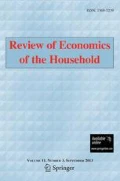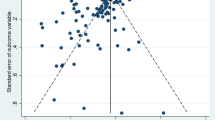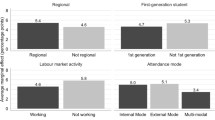Abstract
Title V, Section 510 of the Social Security Act, passed in 1996 and implemented in 1998, appropriates funding to states for the purpose of educating minors on the benefits of abstinence before marriage. Despite considerable research on the impact of abstinence education on teen fertility outcomes, high quality population-level studies on state abstinence education using panel data are absent. This paper uses state-level data to analyze the impact of abstinence education on the birth rates for teens 15–17 years by evaluating the Title V, Section 510 State Abstinence Education (SAE) program. For an average state, increasing spending by $50,000/year on SAE can help avoid approximately four births to teenagers, resulting in net savings of $15,652 to the public for each birth avoided.

Similar content being viewed by others
Notes
Monetary values are in 2004$.
See Advocates for Youth website http://www.advocatesforyouth.org/index.php/publications/429.html?task=view. Accessed 14 December 2010.
Monies are distributed between states according to the following process: Grants are awarded to states based on a statutory formula which is partly determined by the proportion of low-income children in a state to the total number of low-income children in all states according to the latest census data. The state is required to match 75% of Title V funds. See the ACF website http://www.acf.hhs.gov/programs/fysb/content/abstinence/factsheet.htm. Accessed 3 March 2009.
Massachusetts is the only state that utilizes all of its funding in one block.
An example of altering the incentives to childbearing is the Family Cap welfare reform policy in the mid-1990s, which ended the practice of providing families on welfare with cash benefits upon the birth of a new child (Kearney 2008 ).
While this paper focuses on the first category, the youth development program—a relatively expensive initiative—incorporates a more holistic approach to addressing the issue of teen childbearing. See Kearney (2008) for a discussion of this issue.
The programs are My Choice, My Future in Virginia; ReCapturing the Vision in Florida; Families United to Prevent Teen Pregnancy in Wisconsin; and Teens in Control in Mississippi.
Later, I include California in the analysis but the results remain largely unaffected.
The base year for the consumer price index series from the Federal Reserve Bank of Minneapolis is 1982–1984. In this analysis, I use 2005 as the base year. http://www.minneapolisfed.org/. Accessed 23 February 2009.
I use 15–17 year-olds as the treatment instead of 12–17 year-olds because data on the latter age group are not readily available over the length of the period under consideration. Further, the available births data for the excluded 12–14 year-olds account for a relatively small proportion of births for 12–17 year-olds.
In addition, first-differencing eliminates different trends in age-specific birth rates that may exist.
The SAE amount comprises the Title V, Section 510 allocations from the federal government plus the 75% matching contribution of each state.
Increasing spending by one cent/capita means that for an average state with a population of 5 million, total spending will increase by $0.01 × 5,000,000 = $50,000. Given the average state population of 15–17 year-olds is 100,842; the decline in the number of births for an average state equals 4.03. That is, 100,842 × (0.04/1,000) = 4.03.
This is an important policy issue. While the program seems to have an effect on reducing teen childbearing, there is no evidence of a significant impact on Blacks (or Hispanics), who are more likely to be susceptible to early teen childbearing.
In 2002, birth rates show a remarkable dip in comparison to previous years; and this episode is more striking for some state-specific age groups relative to others.
The tendency is for every state to access similar and constant funding levels for CRE. Thus, there is likely to be less variation in CREs across states.
References
Abrevaya, J. (2001). The effects of demographics and maternal behavior on the distribution of birth outcomes. Empirical Economics, 26(1), 247–257.
Akerlof, G. A., Yellen, J. L., & Katz, M. L. (1996). An analysis of out-of-wedlock childbearing in the United States. Quarterly Journal of Economics, CXI, 277–317.
Barnett, J. E., & Hurst, C. S. (2003). Abstinence education for rural youth: An evaluation of the life’s walk program. Journal of School Health, 73(7), 264–268.
Becker, G. S. (1965). A theory of the allocation of time. Economic Journal, 75(299), 493–517.
Becker, G. S., Murphy, K. M., & Tamura, R. (1990). Human capital, fertility and economic growth. Journal of Political Economy, 98(5), S12–S37.
Behrman, J. R., & Rosenzweig, M. R. (2002). Does increasing women’s schooling raise the schooling of the next generation? American Economic Review, 92(1), 323–334.
Borawski, E., Trapl, E. S., Lovegreen, L. D., Colabianchi, N., & Block, T. (2005). Effectiveness of abstinence-only interventions in middle school teens. American Journal of Health Behavior, 29(5), 423–434.
Bronars, S. G., & Grogger, J. (1994). The economic consequences of unwed motherhood: Using twin births as a natural experiment. American Economic Review, 84(5), 1141–1156.
Cabezón, C., Vigil, P., Rojasc, I., Leivad, M. E., Riquelmee, R., Arandaf, W., et al. (2005). Adolescent pregnancy prevention: An abstinence-centered randomized controlled intervention in a Chilean public high school. Journal of Adolescent Health, 36, 64–69.
Cameron, C., Gelbach, J. B., & Miller, D. L. (2006). Robust inference with multi-way clustering. NBER technical working paper T032. http://www.nber.org/papers/t0327. Accessed December 16, 2010.
Cannonier, C. (2011). State abstinence education programs and teen birth rates in the U.S. Working Paper 2009-14(Revised), Department of Economics, Louisiana State University. http://bus.lsu.edu/McMillin/Working_Papers/pap09_14r.pdf. Accessed June 8, 2011.
Card, J. J. (1999). Teen pregnancy prevention: Do any programs work? Annual Review of Public Health, 20(1), 257–285.
Carter-Jessop, L., Franklin, L. N., Heath, J. W., Jimenea-Tizarry, G., & Peace, M. D. (2000). Abstinence education for urban youth. Journal of Community Health, 25(4), 293–304.
Denny, G., Young, M., & Spear, C. E. (1999). An evaluation of the sex can wait abstinence education curriculum series. American Journal of Health Behavior, 23(2), 134–143.
Devaney, B., Trenholm, C., Fortson, K., Clark, M., Quay, L., & Wheeler, J. (2008). Impacts of abstinence education on teen sexual activity, risk of pregnancy, and risk of sexually transmitted diseases. Journal of Policy Analysis and Management, 27(2), 255–276.
DiCenso, A. A., Guyatt, G., Willan, A., & Griffith, L. (2002). Interventions to reduce unintended pregnancies among adolescents: Systematic review of randomised controlled trials. British Medical Journal, 324, 1–9. http://www.bmj.com. Accessed January 20, 2009.
Doniger, A., Adams, E., Utter, C., & Riley, J. (2001). Impact evaluation of the ‘not me, not now’ abstinence-oriented, adolescent pregnancy prevention communications program, Monroe County, New York. Journal of Health Communication, 6(1), 45–60.
Donovan, P. (1996). Can statutory rape laws be effective in preventing adolescent pregnancy? Family Planning Perspectives, 29(1), 30–40. Special report. http://www.guttmacher.org/. Accessed March 10, 2009.
Frost, J. J., & Forrest, J. D. (1995). Understanding the impact of effective teenage pregnancy prevention programs. Family Planning Perspectives, 27(5), 188–195.
Grossman, M. (1972). On the concept of health capital and demand for health. Journal of Political Economy, 80(2), 223–255.
Grossman, M. (2005). Education and nonmarket outcomes. NBER working paper 11582. http://www.nber.org/papers/w11582. Accessed January 21, 2010.
Guttmacher Institute. (2002). Teen pregnancy: Trends and lessons learned. The Guttmacher Report on Public Policy, 5(1), 7–10. http://www.guttmacher.org/. Accessed March 9, 2009.
Henshaw, S. K. (1997). Teenage abortion and pregnancy statistics by state, 1992. Family Planning Perspectives, 29(3), 115–122. http://www.guttmacher.org/. Accessed February 19, 2009.
Hofferth, S. L., Reid, L., & Mott, F. L. (2001). The effects of early childbearing on schooling over time. Family Planning Perspectives, 33(6), 259–267. http://www.guttmacher.org/. Accessed March 9, 2009.
Hoffman, S. (2006). By the numbers: The public costs of teen childbearing. Washington, DC: National Campaign to Prevent Teen Pregnancy. http://www.thenationalcampaign.org/costs/pdf/report/BTN_National_Report.pdf. Accessed April 18, 2008.
Kearney, M. S. (2008). Teen pregnancy prevention as an anti-poverty intervention: A review of the evidence. University of Maryland Research Papers. http://econ-server.umd.edu/~kearney/Papers/Kearney-Teen%20pregnancy-Sep08.pdf or www.econ.umd.edu/research/papers/195. Accessed April 14, 2009.
Kearney, M. S. (2009). Teen and non-marital childbearing. NBER reporter: Research summary, number 1. http://www.nber.org/reporter/2009number1/kearney.html. Accessed April 14, 2009.
Kearney, M. S., & Levine, P. B. (2009). Subsidized contraception, fertility, and sexual behavior. The Review of Economics and Statistics, 91(1), 137–151.
Kirby, D., Short, L., Collins, J., Rugg, D., Kolbe, L., Howard, M., et al. (1994). School-based programs to reduce sexual risk behaviors: A review of effectiveness. Public Health Reports, 109(3), 339–360.
Levine, P. B. (2003). Parental involvement law and fertility behavior. Journal of Health Economics, 22(5), 861–878.
Lieberman, L. D., Gray, H., Wier, M., Florentino, R., & Mahoney, P. (2000). Long-term outcomes of an abstinence-based, small-group pregnancy prevention program in New York City schools. Family Planning Perspectives, 32(5), 237–245.
Martin, J. A., Hamilton, B. E., Sutton, P. D., Ventura, S. J., Menacker, F., Kirmeyer, S., & Munson, M. L. (2007). Births: Final data for 2005. National vital statistics report, 56(6). Hyattsville, MD: National Center for Health Statistics. http://www.cdc.gov/nchs/data/nvsr/nvsr56/nvsr56_06.pdf. Accessed January 20, 2010.
Mathematica Policy Research. (2007). Impacts of four title V, section 510 abstinence education programs. http://www.mathematica-mpr.com/publications/PDFs/impactabstinence.pdf. Accessed April 14, 2009.
Mathematica Policy Research. (2009). Evaluation of abstinence education programs funded under title V, section 510. http://www.mathematica-mpr.com/welfare/abstinence.asp. Accessed March 9, 2009.
National Center for Education Statistics. (2007). Dropout rates in the United States: 2005. Compendium report. Washington, DC: US Department of Education. http://nces.ed.gov/pubs2007/2007059.pdf. Accessed December 19, 2010.
Oettinger, G. S. (1999). The effects of sex education on teen sexual activity and teen pregnancy. The Journal of Political Economy, 107(3), 606–644.
Paton, D. (2002). The economics of family planning and underage conceptions. Journal of Health Economics, 21(2), 27–45.
Santelli, J. S., Lindberg, L. D., Finer, L. B., & Singh, S. (2007). Explaining recent declines in adolescent pregnancy in the United States: The contribution of abstinence and improved contraceptive use. American Journal of Public Health, 97(1), 150–156.
Sen, B. (2003). Can beer taxes affect teen pregnancy? Evidence based on teen abortion rates and birth rates. Southern Economic Journal, 70(2), 328–343.
Willis, R. J. (1999). A theory of out-of-wedlock childbearing. The Journal of Political Economy, 107(6), part 2: Symposium on the economic analysis of social behavior in honor of Gary S. Becker, S33–S64.
Acknowledgments
I thank Naci Mocan for many insights on this project, Carter Hill and the participants at the Louisiana State University Department of Economics weekly seminar presentations, Bob Patterson and Maureen Duran of Administration for Children and Families (ACF) and Patty Mc Grew for providing helpful comments and suggestions. I am grateful to the editor and two anonymous referees whose suggestions improved the paper substantially.
Author information
Authors and Affiliations
Corresponding author
Rights and permissions
About this article
Cite this article
Cannonier, C. State abstinence education programs and teen birth rates in the US. Rev Econ Household 10, 53–75 (2012). https://doi.org/10.1007/s11150-011-9131-8
Received:
Accepted:
Published:
Issue Date:
DOI: https://doi.org/10.1007/s11150-011-9131-8




